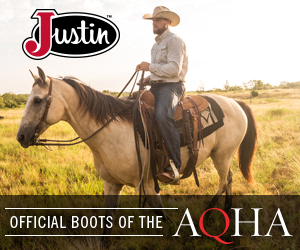NO GATES

Riding in the Mongol Derby, the presence of horses and cattle were familiar to Frank Winters, but the landscape he’d read about since he was a boy was fascinatingly foreign.
Frank Winters knows wide-open ranches but what was waiting for him in Mongolia was beyond open range and beyond expectation.
By Olivia Morris
Photos by Sarah Farnsworth
If you don’t have at least 10,000 acres, you don’t know what a big ranch is.
That’s Frank Winters’ definition of a large ranch. It’s easy to trust his know- ledge of ranching and running cattle on horseback; he’s a fifth-generation cowboy and proud of it.
Frank owns and operates LTF Cattle, a 3,000- to 4,000-head operation in Gruver, Texas. While Frank would be the first to tell you that he belongs firmly on the back of an American Quarter Horse in the Texas Panhandle, he has always had a sense of adventure. When Frank was 14 years old, he stumbled upon a book that would later prove to be a bit of foreshadowing.

Cold rain was a constant for much of the race, adding to the degree of difficulty
“I read Louis L’Amour’s book ‘The Walking Drum’ when I was about 14 years old,” Frank recalls. “He talked about going across parts of Mongolia in that book. Ever since that, I was fascinated by that part of the world. I read every article I could find and looked through all kinds of pictures of Mongolia.”
The area Frank is referencing is called the Mongolian steppe, a vast grassland region covering more than 350,000 square miles of wide-open land. The majority of the inhabitants on the steppe are nomadic and live in gers, the iconic portable tents. Mongolians are known for their horsemanship and durability across the harsh summers and cold winters of the steppe, a lifestyle that Frank, 57, found easy to identify with, having been raised on a ranch.
Reading About a Dream
In August 2018, Frank picked up the latest America’s Horse magazine. He passed articles showcasing the Quarter Horse in different art forms, South American rodeo cowboys and even the AQHA Versatility Ranch Horse World Championships, but one article in particular caught his eye. He recognized the terrain and horses right away.
The article featured Brooke Wharton, an AQHA member who competed in the 2017 Mongol Derby. It detailed her weeklong journey across the same Mongolian steppe that had captivated Frank for years.
“I’ve picked up every piece of literature on Mongolia I could find over the years,” Frank says. “So to find out that there was a race like that, in Mongolia, I just had to find out more. I followed the link to the race website, www.theadventurists.com, and there it was. They said you could ride for 650 miles without ever opening a gate. I had to see that.”

Could you look at this group of non-English-speaking horse owners and their ponies and reliably select the best mount? Frank developed a system to do just that.
Again, the stars aligned for Frank, and the 2018 Mongol Derby had just kicked off when Frank stumbled on to the website. He was hooked.
“The race was just getting ready to start when I started tracking it,” he says. “I guess I got overly involved in the race that year. The funny thing was, I clicked on another link on the website that I thought would sign me up to get updates. I thought it would be cool if I could track it during the day.”

It’s fair to say that Frank knows horses better than he knows the internet. That link was actually the registration application for the 2019 Mongol Derby.
“Once I realized that it was the application, I thought ‘Heck, I could do that,’” he says. “So, I filled it out and sent it in. After about two days of not hearing anything, I got really nervous and followed up. Almost immediately, they responded and said they really liked my application and moved it over to the interview pile. I didn’t even know you had to interview. A couple of days later, I got a phone call from a race representative, and that was the interview. They moved my application over to the invitation pile.”
Days later, when Frank received an official invitation in the mail, it began to sink in. He was set to compete in the famed Mongol Derby, one of only 40 riders accepted from more than 2,000 applicants.
The World’s Toughest Horse Race
The Mongol Derby isn’t easy to explain, mainly because it’s fairly open to interpretation. To simplify, each competitor will travel roughly 1,000 kilometers (630-650 miles, depending on their routes), passing 28 checkpoints along the way. A rider’s route between checkpoint stations is entirely up to him and his GPS.
According to www.theadventurists.com, these same lands were used by Chinggish Khan in 1224 to establish the world’s longest postal transmission system. Much like the race, riders would travel from station to station transporting mail in a matter of days, not months, cutting down the time between communication transactions.
Now at each station, Derby riders select one horse from a local herd, and they have between the hours of 6:30 a.m. and 8 p.m. to travel to the next checkpoint. Stations are roughly 20 to 30 miles apart, and riders are required to exchange horses at each stop. Vets closely monitor the condition of the incoming horse and rider at each station before the competitor is allowed to select his next mount and travel to the following checkpoint.
The Countdown
Once the dust settled, the gravity of what Frank had committed to was heavy. After all, the Mongol Derby is widely known to be one of the most grueling horse races in the world.
“I remember asking my wife, Laura, if she thought I could do this,” he says. “She said that she knew I could, but I was never as sure as she was.”

Adding familiar western fenders and stirrups, as well as bucking rolls, to a saddle gave Frank an added degree of confidence. The Mongol ponies, though big-hearted and tough, sometimes had big bucks in them, as well.
The race isn’t cheap. With a $14,500 price tag before airfare, equipment and training expenses, it’s quite an investment. Frank’s goal was to raise money for the trip without financially straining his family.
“I thought I was going to get sick when I finally pushed the button to finalize my spot,” he says. “I was so nervous. I raffled off a rifle, a half beef, sold a saddle, sold a horse and anything else I could do to make it easier.”
Frank received his official invitation and secured his spot in the race in October 2018, leaving him 10 months to train for the race. Luckily, the horseback piece was not as intimidating to Frank as it may be to some. The majority of his day is spent horseback on the ranch.

“We ride a lot on the ranch,” Frank says. “I don’t use ATVs to run my cattle, we use horses. When you work cattle, you may lope over to a herd to check on them, long trot over to the next and walk to the one after that. On any given day, I may ride 15 to 20 miles, but when I started doing the endurance riding, I learned quickly that there is a big difference between what I do and riding in a straight line to get somewhere like they do.”
Frank knew there would be a learning curve between ranch riding and endurance riding. But one thing was the same: Horses are horses.

How do you find your way around the Mongolian steppe if reading a GPS isn’t your thing? You get by with a little help from your newfound friends.
“There was a lot of my experiences on the ranch that helped me with the horses there,” Frank says. “All of my life, my forte has been that I can get along with anything. I’ve ridden spoiled, bad or easy horses all my life. I can typically get them lined out. That experience was probably my biggest asset out there. But one thing that was really exciting to me was to find out just how different those horses were from our Quarter Horses.”
Even with that similarity, Frank would face a new climate and new tack – as well as new horses – and he didn’t take the challenges lightly.
“Training for this consumed my life,” he says. “I just started riding a lot. One thing I learned about was the special saddles they used for the horses over there. I just wanted to take my own saddle, but I ordered one of those and got it adjusted for me.”

All participants were able to use their own fenders and stirrups, though, and Frank’s were what he was accustomed to – off a western saddle. He also added bucking rolls, which gave him added confidence with the sometimes-boisterous Mongolian horses.
Frank also wasn’t shy about reaching out to past participants for help, including Devan Horn, a two-time reserve champion in the Derby.
“She invited me to go down in March and spend some time riding with her in Houston,” Frank says. “We rode 95 miles in 13 and a half hours. Funny enough, she had a 35-mile trail mapped out that went around the Bush International Airport. As far as preparation, that was one of the best things I did. She gave me some tips and told me that I was on the right track. That was the confidence-building piece that I needed.”
Finding Friends Far From Home
When August finally rolled around, Frank was ready to take off. He boarded a plane in Amarillo bound for Denver and flew from Denver to San Francisco to Beijing and finally landed in Ulaanbaatar, the capital of Mongolia.
“Getting there was a snap,” he says. “I got really lucky as far as jet lag. I left the states in daylight, got to Mongolia in darkness, went to bed and woke up adjusted. Coming in reverse was the opposite. I suffered from jet lag for about two weeks. That was my first time traveling like that. One of the big items I had to check off my list of things to get was actually a passport.”
After landing and spending a night in Ulaanbaatar, the contestants were transported to the Mongolian steppe for a day of training prior to the race beginning. Frank, having spent 40 years longing to see the Mongolian countryside, found himself right at home among the new landscape, people and horses.
“This seems to be true to me wherever you go,” he says. “Country people are country people. The Mongolian people were friendly and fun-loving. They would have fit right into the Texas Panhandle. Going into their homes was just like if you had walked in to my house. The atmosphere at each station was just like a branding here in the states. All the neighbors get together, cook a big meal, and the camaraderie was really similar between the families.”

Frank says that country people are all the same, no matter where you go, and he felt comfortable with the Mongolian nomads.
Before the race began, Frank was required to pass weigh-in. According to race regulations, riders and their carry-on equipment could only weigh 85 kilograms (or 187 pounds) due to the smaller stature of the Mongol horses.
“I was really sweating weigh-in,” he says. “The day I signed up for the race, I weighed 190 pounds. But you can only weigh 187 pounds dressed to ride. That includes your boots, pants, helmet. I had been on a special diet for a year and when the day came, I stepped on the scale at 84 kilograms and was so excited! That was the first hurdle.”
On the day the race began, Frank watched a storm roll in. He knew the weather on the steppe was known to change quickly, but this storm was much of what marked his first three days of racing, raining solid day and night.

“On the first day, when we rode into the second station, the instant I stepped off my horse soaking wet, I was freezing. I was shivering so hard that I couldn’t even get my fleece jacket on. A vet came over and suggested I take some time to warm up before choosing my next horse and taking off again, but I didn’t stop, my group was in the lead at that time. Weather was definitely an added challenge.”
Rider are encouraged to pass checkpoints at as many as four to five stations a day, riding between race regulation hours. Transitions were just as crucial as navigating your path between stations with a race-issued GPS system. Frank learned quickly that reading horses at each station was much easier for him that utilizing the unfamiliar GPS. The solution? Befriending other competitors with unique skill sets.

The iconic Mongolian gers provided sanctuary from the capricious weather.
“Navigation is why I ended up riding with the Australians,” he says. “If it was up to me, I would still be over there lost. When you’re going across land that is completely unfamiliar to you, you don’t have a clue as to where you are or where you’re going. Luckily, on the second day, I ran in to Sam Chisholm, an Aussie who understood the GPS really well. We started riding together and made an agreement. He would navigate, and I would pick horses at each stop. Together, we made a pretty good team.”
Sam’s navigation expertise was invaluable to Frank. The pair quickly settled into a rhythm between stations, and he was free to focus on his responsibility of choosing horses for the pair. Some would look solely at conformation, and some would watch the horses move before making a choice, but Frank had a different idea.
“I was probably three days into the race before I really understood how to best pick a horse out,” Franks says. “I was under the impression that when you arrived at one of the stations, the horses that were there belonged to the person whose station you were at. But the fact is, the horses there were a conglomeration of the people who lived in that area. It’s a pool of the horses, and the owners were all there watching. Once I figured out that the six or seven men standing around were the owners of the horses, I would look for the owner who looked most like a horseman. We didn’t speak the same language, but I could find the owner who was the proudest of his horses, and I would ask him for his favorite horse. They took a lot of pride in you picking their horse. For me, it became a contest of judging the person just as much as the horses.”
Day 4 was Frank’s favorite day and the climax of the race.

“We started off fresh and had awesome horses. After the second station of the day, we passed the leader and by 6 p.m. were still in the lead. As we rode into one of the stations, we really had to be strategic about our next move. We only had an hour and a half left of riding time, and we thought there was no way we could get to the next station 21 miles away before the 8 p.m. cutoff, but we took off anyway. My horse was wicked fast, and one of the riders in our group suggested that we see what the horses could really do, so I gave my horse his head, and he absolutely took off. He was just like a little locomotive.”
The group crossed the line at the station with only seconds to spare, accomplishing Frank’s goal of making it to five stations and riding five horses in one day, a total of 120 miles. He was amazed at the ability of the Mongolian horses.
“Those horses are known to be tougher than nails, but I didn’t believe it.” Frank says. “After that day, I was the biggest believer there. Those little son-of-a-guns are the toughest horses anywhere alive. I can’t say it strongly enough for people to understand just how tough these little horses were. For me, it’s what is inside of one that matters.”
For the next three days, Frank and his group of friends traveled the steppe from station to station. He eventually crossed the finish line in seventh place. His last leg to the finish line consisted of a grueling 28 miles of continuous loping. Frank’s total race time was seven days, seven hours and 59 minutes.
Reflecting on a Dream
After returning home, Frank spent several days in a daze. It is hard to explain to others the impact of accomplishing your dream.
Frank isn’t sold on competing in the Mongol Derby for a second time; the first was just that special to him. He does have his eye on another endurance race in Patagonia, however. We haven’t seen the last of this rancher turned racer.
“One thing that blew me away was how unprepared I was for the end of the race,” he says. “You just focus on getting from point to point, the end never crossed my mind. I was so emotional. At the end, I knew there was a finish party, and they would ask your thoughts on the race.
“I had time to think on it, and my toast was ‘If you’re not dead, live.’ Everyone has something that drives them. If you aren’t dead, go do it. I sold saddles, horses, rifles to get to do what I was passionate about.
“I can’t stress that enough: Just go live.”
Olivia Morris is a former AQHA Media employee who freelances from her home in Kingston, Washington.

